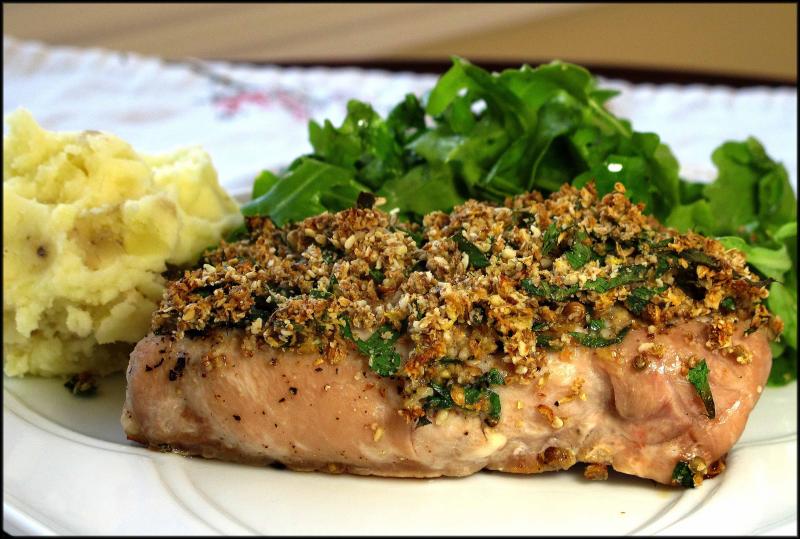Ways to enjoy a tasty, tender, juicy pork chop
In a recent conversation, my friend Dotti Wiker asked me if I faced the same challenges she found when cooking pork chops. She was specifically referring to those super-lean, thin, boneless chops that arrive on your dinner plate with all the texture and moisture of the proverbial shoe leather.
The fault might be in the pig itself. The original breeds of swine raised for their meat are disappearing, replaced in large-scale industrial agriculture by those bred for the conditions found on factory farms. Instead of qualities such as flavor and hardiness, these are bred for growth rate and size at maturity.
There are a few ways to enjoy a tasty, tender, juicy pork chop. The first is to know the source of your meat. Look for producers who allow their swine, especially heritage breeds, to freely graze in pasture and woodlands. Local examples include Grass Works Meat Farm outside Seaford and Long Meadow Farm in Greenwood.
The second step to a better pork chop is to understand the different types of chops. Shoulder, blade and sirloin chops have bones and generous marbling throughout. These should be braised for a long time with low, moist heat. As the meat cooks, the collagen dissolves and the fat renders, resulting in fall-off-the-bone tenderness.
Rib, loin or boneless chops are all quite lean and sometimes sold in very thin slices. The secrets to cooking these are twofold: brining and short cooking times. After spending 30 minutes in a simple brine of salt, sugar and water, pork chops will plump up and retain moisture when they're cooked.
Although we've been warned about the dangers of undercooked pork, many of us might be surprised to know that the safe internal temperature for pork is 140 F. At this point, the meat may still have hints of pinkness, which is also a sign you've not overcooked it.
The ideal cooking time for a breaded or otherwise coated pork chop is between 10 and 15 minutes. Keep in mind that once you remove the chop from the skillet or grill, it will continue to cook slightly, so let it rest for about 5 minutes under a tent of aluminum foil.
Since pork is a fairly lean, bland cut of meat, seasoning is essential. A brine is most desirable, while a generous sprinkle of salt and pepper will definitely help.
A coating of herbed mayonnaise followed by dredging in seasoned bread crumbs is a tried and true way to retain moisture in a baked chop.
Another technique is to dip the pork chops in egg wash, seasoned flour or grated cheese, back to the egg wash and finally in bread crumbs. These quickly bake to perfect tenderness. In this approach, you can vary the flavor profile based on the seasonings in your bread crumbs.
To make the chops in the photo, we used a variation on a spice mixture known as dukkah or duqqa. With a number of variations, the key ingredients are finely chopped nuts, sesame seeds, coriander and cumin. We mixed in garlic, lemon zest and parsley, but didn't use any chopped mint, a common addition.
I've included recipes for an easy brine and the baked chops with dukkah topping. If you're in a hurry and want to skip brining, try the skillet chops with a crunchy Parmesan bread crumb crust.
Pork Chop Brine
1/2 C sugar
1/4 C salt
4 C water
Combine ingredients in a deep glass pan, stirring to dissolve the sugar and salt. Submerge chops in the mixture and cover with plastic wrap. Refrigerate for 30 minutes. When ready to cook, remove chops from brine and pat dry with paper towels; do not rinse.
Dukkah Crusted Pork Chops
4 1/2-inch thick boneless pork chops
1 C roasted almonds
3/4 C sesame seeds
1 t ground cumin
2 T coriander seeds
2 garlic cloves
zest of 1 lemon
1 T olive oil
salt & pepper
Brine pork chops (see above) for 30 minutes. Coarsely grind the almonds and place in a small bowl. Stir in sesame seeds and cumin. Roughly grind the coriander seeds and add to mixture. Grate garlic cloves into the mixture and stir in lemon zest.
Add olive oil and stir to combine; adjust seasonings with salt and pepper. Preheat oven to 400 F. Remove chops from the brine and pat dry with paper towels. Line a baking sheet with aluminum foil and arrange chops in a single layer. Cover each chop with a thick layer of dukkah. Bake until internal temperature reaches 140 F, about 12 to 15 minutes. Rest the chops under a foil tent for 5 minutes before serving.
Parmesan Pork Chops
4 1/2-inch thick boneless pork chops
salt & pepper
2 eggs
3/4 C grated Parmesan cheese
1 C bread crumbs
1/2 t marjoram
1/2 t basil
4 T oil
1 T butter
Rinse the chops and pat dry with paper towels. Sprinkle with salt and pepper on both sides. Gently beat the eggs in a small bowl. Place the Parmesan cheese on a paper plate. Combine the breadcrumbs, marjoram and basil on a paper plate. Dip a chop in the egg wash and shake off any excess. Dredge the chop in the Parmesan cheese, coating both sides. Dip the chop again in the wash and then coat with bread crumb mixture; set aside. Repeat with remaining chops. Heat oil and butter in a heavy skillet over medium heat. Add pork chops in a single layer. Cook 6 minutes each side, turning once. Remove from heat and rest chops under a foil tent for 5 minutes before serving.

























































